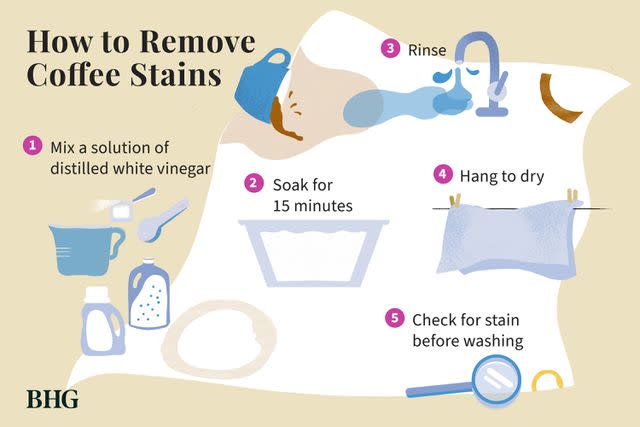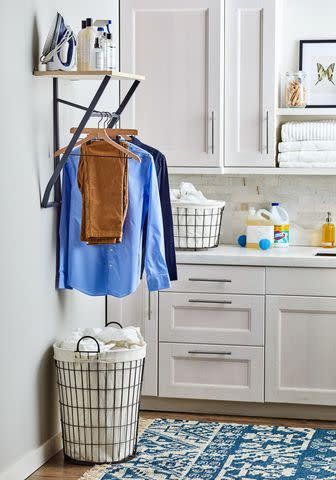How to Remove Coffee Stains on Clothing with 3 Household Products

Follow these tips to conquer coffee stains using products you likely already have in your laundry room.
Fact checked by Marcus Reeves
If you typically start your mornings with a cup of coffee, it's almost inevitable that you'll have to deal with drips or spills at some point, so knowing how to remove coffee stains is essential. Unfortunately, coffee can leave a dark, ugly stain, especially on lighter fabrics. But don't fret! These stains usually come out with simple cleaning strategies involving products you likely already have on hand, including vinegar and bleach.
Related: We Tested the 27 Best Travel Coffee Mugs, These Are Our 6 Favorites

BHG / Michela Buttignol
How to Remove Coffee Stains
Whichever coffee stain removal method you choose, you mustn't place the garment in the dryer until the stain is completely gone. Machine-drying the item while a coffee mark is still visible can set the stain and make it nearly impossible to remove.
As with most fabric stains, it's best to act quickly when treating coffee stains on clothing. If the spill just happened, immediately remove the garment and flush the fabric with cold water through the back of the fabric. This can prevent the stain from penetrating the material and becoming more difficult to lift out. If a simple cold-water rinse doesn't do the trick, or if the stain is older than a few minutes, try one of these proven methods for removing coffee stains from clothing.
Related: 10 Best Stain Removers for Clothes, Linens, and Upholstery Fabric
How to Remove Coffee Stains with Vinegar
Dried coffee stains on clothing often require a soak in a cleaning solution to completely lift out the spot. An effective method for how to remove coffee stains in a few minutes is with a solution of distilled white vinegar, liquid detergent, and water. This coffee stain removal mixture works well on most types of clothing, but if you're worried about damaging the garment, test the technique on an inconspicuous area first.
Mix the following in a bucket or other large container:
1 quart lukewarm water
1/2 teaspoon liquid dishwashing detergent
1 tablespoon white vinegar
Soak clothing in the solution for 15 minutes, then rinse and hang to dry. Check the area to see if the stain remains. If the stain is gone, you can go ahead and wash the clothes.

How to Treat Coffee Stains with an Enzyme Presoak
If your coffee stain is a little more stubborn, try this cleaning method. First, use a white sponge to dab rubbing alcohol on the stain, working from the outside to the center. Then in a small bucket, mix a batch of:
1 quart warm water
1 tablespoon enzyme presoak product
Place stained clothing in the bucket and allow it to soak for 30 minutes. Remove the garment and check the stained area. Again, if you can no longer see the stain, you're safe to wash the clothing as normal.

How to Remove Coffee Stains on Clothing Using Bleach
If the stain remains, wash it using chlorine or oxygen bleach. This method for how to remove coffee stains might be necessary for old or set-in spots. Always check the label to make sure the bleach is safe to use on that fabric. Generally, you shouldn't use bleach to treat coffee stains on spandex, wool, silk, mohair, or leather. Mix 1/4 cup chlorine bleach and a gallon of water, and soak the garment for five minutes before rinsing and washing as usual.
How to Remove Other Stains
11 Genius Guaranteed Methods for How to Get Gum Out of Clothes
How to Get Red Wine Out of Couches, Clothing, Carpet, and More
Frequently Asked Questions
Will a coffee stain go away on its own?
No, coffee stains won't disappear without treatment. If left to sit, coffee stains can be hard to remove, so use one of the techniques listed as soon as possible to remove any coffee stains.
How long does it take for coffee to leave a stain on clothes?
Coffee will stain clothes as soon as a spill or drip happens. The sooner a stain is treated, the easier it will be to remove. Never put a garment stained with coffee in the dryer—that could make it permanent.
For more Better Homes & Gardens news, make sure to sign up for our newsletter!
Read the original article on Better Homes & Gardens.

